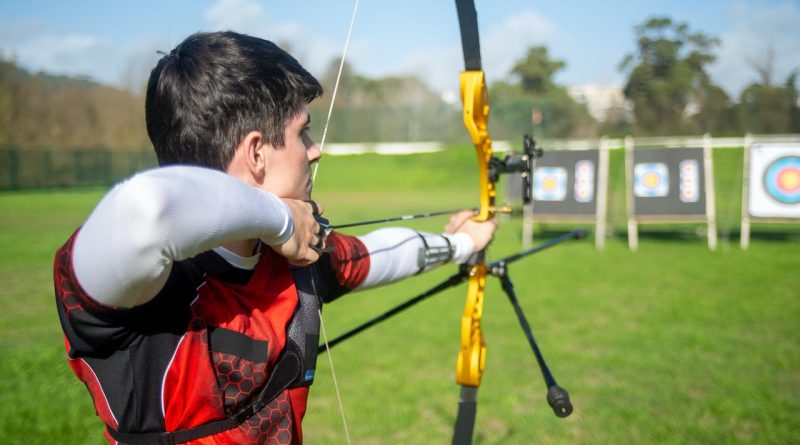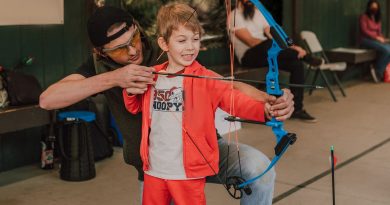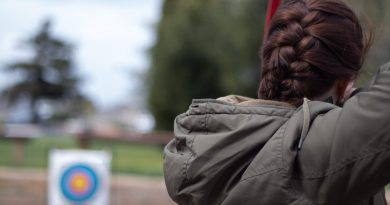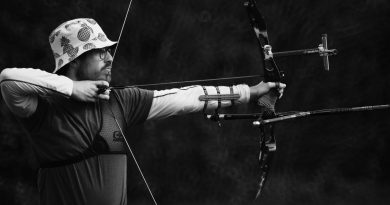Construction of a Field Roving Course
The growing popularity of the field roving course can be directly attributed to the similarity between the field course and conditions encountered in the hunting field. The recent influx of bowmen into the hunting field has created a demand for this type of course. Field roving is a game and, like golf, there have been established certain standards which must be followed in the construction of a course to insure comparative scores and uniform classification of archers in accordance with their abilities. The National Field Archery Association has formulated certain basic requirements which must be met when a field course is constructed in order that the completed course will be officially sanctioned by the National Field Archery Association. This approval is given by the Secretary of the N.F.A.A. or his duly accredited representative. The officials of the local club must submit affidavits to the secretary that all measurements are correct, and where approval of the secretary of the N.F.A.A. is desired, such data as maps and photographs of the completed course must be submitted to the secretary. In practice it is highly desirable that the members of a new club seek the advice of an experienced field roving archer in laying out the course. If possible, the state representative of the National Archery Association should be contacted and his advice or services obtained in laying out the course. Proper planning in the selecting of the site and the layout of the course, prior to the actual construction, will do much to insure the future success of the club.
The basic principles which should be followed in planning and constructing a field roving course are readily understood. With a working knowledge of these basic rules a course can be built which will be a pleasure to shoot and a challenge to your ability as an archer.
A standard field roving course consists of two units of 14 targets each. Twenty-eight targets permit shooting the official round without repeating on any target. If space or other limitations prevent the construction of both units, a single unit of 14 targets can be used and shooting twice around the unit constitutes a round.
Selection of the Site
A plot of ground of at least 10 acres is required for each unit of 14 targets. Rolling terrain should be chosen, and wooded hills and valleys are considered ideal for a course. Along with the scenic beauty of an ever changing landscape, the forest canopy reduces the problem presented by underbrush and vegetation in many parts of the United States. If the undergrowth can be kept to a minimum without the use of manual labor, the benefits are self evident. In mid-continent, the problem is not so much one of vegetation as it is to find a site with sufficient changes in elevation to provide an interesting variety of shots. A nearby arroyo or the lower slopes of a canyon should be investigated for possible locations.The site selected should be accessible by a good road, and be within reasonable driving distance from the community in which the club members reside. The nearer the site to the community, the better, as its availability will permit shooting over it when only a limited amount of time is available. Small communities should be able to locate a site in the immediate country side, whereas those who reside in the larger cities may find it possible to make arrangements with the local officials to locate the range in an unused section of one of the public parks. If the choice is a public park and the authorities require that the range be open to public use, they probably can be induced to help finance its construction and future maintenance.
If you choose as a location a site on private property, the owner should be contacted and a lease drawn with the owner for the use of the site. There are many wooded and waste sites which land owners should be willing to lease for a nominal sum of money provided that they could be assured that they would not be held liable for accidents which might occur on the property and would receive compensation for any property damages that might result from club activities. To safeguard the owner and the individual members of the club, liability insurance should be carried by the club.
In choosing a site, give consideration to facilities for parking cars. The absence of such facilities has been noted at a number of the recently constructed ranges. Congestion resulting from parking along the highways leading to the range and the inconvenience the bowman encounters in carrying equipment and tackle to and from the range, detract from the pleasure one should derive from shooting the course. Ample space should be provided in the central area where non-shooters of the family can picnic and enjoy outdoor recreation, although they do not participate in the shoot. This central area should be chosen with the possibility in mind that a club house may be constructed at a future date. A good supply of potable water is essential. The course should be planned around the central area, so that there will be no danger from stray arrows, or interference from non-participants intruding on the shooting range and exposing themselves to danger.
Location of the Units
The best layout consists of two units of 14 targets each. Targets numbered one, 14, 15, and 28 should be located adjacent to the central area and archers should be able to travel to and from each of these targets from the central area without crossing the field of fire of any target on the course. It requires approximately two hours to shoot the full 28 target field roving course and it may be desirable to return to the central area during this period of time. A sudden violent thunder shower, a broken piece of tackle, etc. will necessitate returning to the central area, or to the parking lot. To avoid a long walk and the danger of cutting across the course, such a layout is highly desirable, and the effort expended in the planning stages will be amply repaid in the comfort and convenience afforded the archers on the completed range. A standard unit is approximately six hundred yards in length and an added benefit received from careful planning is that during tournaments, target assignments can be reached without a long walk and consequent delay in starting the shoot, in order to permit those assigned to outlying targets to reach their assigned stations.With the location of four of our target ranges and shooting positions located, we are ready to reconnoiter and select suitable locations for the remaining targets. These sites must be chosen with the knowledge that contestants in a shoot will be progressing from target to target over trails that traverse wooded areas in many cases. Therefore, the first consideration is to insure the safety of the contestants. This is accomplished in the same manner as that used in laying out a golf course. No trail should cross the range of another target, neither should it cross in close proximity to the back of another target. A trail, target, or shooting position should never be closer than 40 feet to the line of fire to another target.
Arrows will miss the target-butt on numerous occasions, and a background should be provided, clear of vegetation, and so constructed or chosen that it will serve to stop arrows, but not break them or cause them to ricochet. Avoid placing a target on the brow or crest of a hill. Without a backstop, an arrow which misses the butt will pass over the crest in free flight, endangering persons on the far slope. The chances of recovering such an arrow, without a prolonged search, are practically nil.
Breakage of arrows can be expensive. Have your background free from rocks, and with no large trees directly in back of the target. If the ground is hard, plow furrows at right angles to the line of flight and pile the soil in ridges. When retrieving arrows, walk in the furrows so that the soft earth ridges will be reserved for their intended purpose of stopping the arrows without damaging them. The lost arrow, like the lost golf ball, can slow up the entire group of contestants; so keep this fact in mind and construct a cleared area in the immediate rear of each butt.
The Shooting Position
A shooting line, at a single position shot, should be at least 10 feet in width, with the shooting peg located in the center of the line. Field archers are generally assigned to targets in groups of four, and at a single position shot it is customary for two of the group to take positions, one on each side of the shooting peg, immediately back of the shooting line, and shoot at the same time. On shots of 60 yards or more, the target should set in the middle of a clearing at least 10 feet in width, and this distance should be reduced gradually in front of the target to take care of the average undershot. Attention to these details, which are common to all targets on the course, will add to the pleasure in shooting a round. Such planning is especially necessary when the club has a high percentage of beginners in the organization. Searching for lost arrows detracts from the pleasure of shooting a field roving course; and since arrows are expensive, breakage and loss can be excessive if the layout is not wisely planned and constructed.
There is no precise guide for locating the layout for your individual shots, because there are no two pieces of terrain that are identical. Certain yardages have been established as standards for the different sized targets, and it becomes the duties of the members laying out the course to select the locale which will provide shots that are within the prescribed limits. A variation of five percent on a shot distance is permitted if the terrain does not permit the full yardage. However, the shortage must be made up on another shot in the round, and in the same unit.
Before you actually begin your layout, make several trips over the terrain weighing the values of the different topographical features against the yardages required for the different shots, and consider the ease with which trails can be constructed from each target to the next shooting position. Trails should provide a good footing and ascend and descend on easy grades, so that they will be a pleasure to traverse. Remember, your club will be composed of men of all ages, women and children, that they have joined your club because they enjoy archery, and are not interested in mountain climbing, which is a sport in its own right. I attended a field roving shoot recently where the participants were required to shoot from an unbalanced rock placed on top of the root system of a tree which had fallen in a gully. The approach to the position was hazardous. It was necessary to climb down the slippery clay bank of the gully to reach the tree, and a slip could have caused painful injury. The insecure footing at the shooting peg made the position actually dangerous. I studied the surrounding area and I could conceive no circumstances which would require a bowhunter to place himself under such a handicap were he actually hunting in the area.
Shots
Now for the detailed shots that make up a standard fourteen target unit. They need not follow in the order listed in the following tabulation, but each one of the shots must be included in each fourteen target unit. One Position Shots at a 12-inch face.Four arrows at each of four targets, spaced at fifteen, twenty, twenty-five, and thirty yards, respectively. One Position Shots at an 18-inch face.
Four arrows at each of three targets, spaced at forty, forty-five, and fifty yards, respectively. One Position Shots at a 24-inch face.
Four arrows at each of three targets, spaced at fifty-five, sixty, and sixty-five yards, respectively. Four Position Shots at an 18-inch face.
Four arrows, each one to be shot from a different position but at the same distance of thirty-five yards from the target.
Four arrows, shooting one arrow at each of the following distances: thirty, thirty-five, forty, and forty-five yards, respectively. Field archers call this type of target a “walk-up.” Four Position Shots at a 24-inch face.
Four arrows, shooting one arrow at each of the following distances: fifty, sixty, seventy, and eighty yards, respectively. This eighty yard shot, with a five percent permissible variation in yardage, is the longest shot on the course. Four Position Shots at a 6-inch face.
Four arrows, shooting one arrow at each of the following distances: twenty, twenty-five, thirty, and thirty-five feet, respectively.
The last three shots, which are the walk-ups, are customarily shot in the order of decreasing yardages, but it is permissible to require that they be shot in the reverse order.
Our plan has now progressed to the stage where we can select tentative sites for the individual shots. Bear in mind the various changes in topography you have marked in exploring your site, and make your layout of shots so that the distances are hard to estimate. An intervening rise in the ground between the shooting position and the butt is one example of a shot where it is difficult to estimate the yardage. Avoid long shots up a steep hillside. If you desire a shot at a high angle, keep the yardage short and build an easy winding trail to the target from the shooting position. A slight difference in elevation between the shooting position and the butt on long shots will prove quite deceptive, as the shooter will not be conscious of the change in elevation.
All shots should be selected and marked before any construction is undertaken. Take two pieces of cloth, one white and the other colored. Tear them into long narrow strips. When you have selected a tentative site for a shot, tie a white strip on a limb or bush, or affix a stake at the spot to mark the shooting position; and in like manner tie a colored strip at the proposed site of the target or butt. Continue in this manner until all of the shots have been laid out on the ground. At this stage, changes and adjustments can be made until you have a satisfactory unit layout and no actual labor will be wasted.
Trails
The next step is to blaze the trails. Keep to a uniform, easy-grade and bring each trail to an end at the rear of its respective shooting position. This adds a built-in safety factor to your course, which is of paramount importance. A trail which parallels closely the flight line of a shot is dangerous, as arrows may be deflected from the line of flight to the target by striking twigs or leaves, and endanger those walking on the adjacent trail. The trails should be constructed so that they are smooth, wide, and free from rocks or obstructions which would hinder a firm footing. A difficult trail annoys the bowman and prevents conversation. Is there an archer who does not enjoy a post mortem as he moves toward the next shooting position?
Construction
Our layout has been fixed on the ground, and we may proceed to the actual construction work. All travel on the course should follow the blazed trails. In wooded or brush covered territory carry a pair of pocket size pruning shears and trim out obstructions as you walk over the trails. As the work progresses from shot to shot, improvements on the trails will be accomplished at the same time.
Clear the necessary areas at the shooting position and at the target butt. On the flight line remove only those obstacles which prevent a clear view of the target, or would obstruct an arrow as it rises and falls on its line of flight to the target. Use a mattock to grub out the stubs of small trees and brush which have been cleared from the line of flight and the trails. They trip the unwary and can cause serious injury.
Paint shooting pegs white, and paint the number of the shot on the shooting peg on the side facing the bowman, as he approaches the shooting position along the trail. On four position shots, designate the order in which the shooting is to be done by adding additional numbers: one, two, three, and four to their respective shooting pegs. For example,
Butts
In sections of the United States where rye is one of the crops produced on the farms, the three wire bale of rye straw, made with a stationary baler, can generally be obtained. This is the most satisfactory type of baled straw to use for your butts. Recently a field baler has come into wide use in some sections of the country.
This baler produces a bale weighing about forty pounds, bound with twine. The bale is unsatisfactory for use in the butts. The straw is not compacted sufficiently to stop the arrows, and the binding twine is easily severed by arrows. The three wire bale from the stationary baler will weigh approximately one hundred pounds. The arrows will penetrate well but not pass through this bale. The straw is compact and weathers well. Use one bale of straw for six and twelve inch targets, two bales for eighteen inch targets, and three bales for the twenty-four inch targets,
Drive at least two posts firmly into the ground at the back of the stack of bales, and wire the butt to them. This precaution is necessary to prevent arrows breaking if the butt is accidentally tipped over while arrows are drawn from the target, or by the wind, or other cause, while arrows are in the target.
Faces
Several types of faces may be purchased or you can make your own from the material used in cardboard shipping cartons. Animal silhouettes are frequently superimposed on the standard faces and provide an interesting target. Each face has an aiming spot in the center of the inner circle, or bull, and in addition an outer scoring ring. There are four official face sizes and the shots on which each size is used have previously been tabulated. To secure additional life from the target faces, it is customary to glue each face to a corrugated paper backing. Many clubs have experienced trouble from rodents destroying the target faces. These animals apparently develop a taste for the glue used in pasting the paper face to the backing. A second coat of glue applied to the backing and then dusted with a coat of powdered dusting sulphur is an excellent deterrent.
The twenty-four inch face has a twelve inch center bull and a four inch aiming spot; the eighteen inch face, a nine inch center bull and a three inch aiming spot; the twelve inch face, a six inch center bull and a two inch aiming spot, and the six inch face has a three inch center bull and a one inch aiming spot. The faces are attached to the butt with large wire staples, which can be made from ordinary wire clothes hangers.
The rules of the N.F.A.A. provide that roving faces must not be super-imposed on any other large target, nor is it permissible to have any marks on the butt or foreground that could be used as a point of aim. In case a standard target bast is used as a butt on a field roving course, the center of the face of the roving target must be set at least eight inches above or below the center of the bast, which in target competition is set four feet above the ground. If several of these basts are used, the position of the target face must vary at least sixteen inches on consecutive shots. On every third bast the lower edge of the target face shall be placed within three inches of the ground.
Plan your course wisely. If you insist on building a rugged one where old clothes and spiked boots are necessary to negotiate the trails, and two rounds on a summer day exhausts even the club Tarzans, it will not be long until the vegetation takes over the trails again. Even the hardy members of the club will do more talking about their course, than shooting over it, and the membership will be slowly declining toward the vanishing point.




